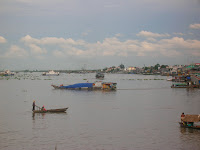 Friday 30 July: So far this trip I've tried to avoid it, but finally I find myself travelling around Angkor's 11-mile circuit on a child's toy - yes a bicycle (61st mode of transport). The country lanes are pancake-flat and a cycle really is the best, most enjoyable, way to see the sites and you have the additional freedom to stop when the mood takes you.
Friday 30 July: So far this trip I've tried to avoid it, but finally I find myself travelling around Angkor's 11-mile circuit on a child's toy - yes a bicycle (61st mode of transport). The country lanes are pancake-flat and a cycle really is the best, most enjoyable, way to see the sites and you have the additional freedom to stop when the mood takes you.Early morning I peddle my way east to Banteay Samre built by Surya II (1112 to 1152), who also constructed Angkor Wat and the distant, now completely overgrown, Being Melea.
Then I head back west, towards the main complex, through pretty rice fields to Ta Prohm where jungle and temple meet. Most of the foliage has been cut back leaving only the big rooted Spung and Chambak trees, which are now all that bind the masonry together. This is the temple featured in Tomb Raiders the movie.
A couple of miles further west is the Hindu temple of Ta Keo, a stepped-pyramid structure with five lotus towers on top. It's of early classic design built by Jaya V (968 to 1001).
Back on my bike, the sun is shining, the temples and landscape are fantastic and there's a pleasant tune replaying in my head:
I've got a bike, you can ride if you like
it's got a basket, a bell that rings
and things to make it look good
I'd give it to you if I could
but I borrowed it
Some photos of the inner circuit temples.
This is a great day - and not had lunch yet - there is more see . . .





















